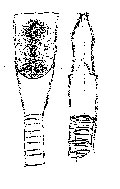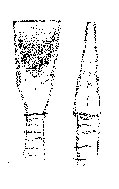HIP hip
April 2009
As our continuing discovery of HIP (Historically Informed Performance) unfolds, we often find that when one thing is changed, it affects other elements of the ensemble. We are sure that our strings, bows, horns and trumpets are as near as possible to what was played in the early 18th century.
Double reed instruments such as oboes and bassoons are a more delicate matter, since, although a few original examples of instruments exist, there are almost no surviving reeds and only a couple of paintings (click on "reeds") with sufficient detail from which to draw conclusions. This means carte blanche to some. Nowadays, players often make their own reeds, which, along with the commercial reality of trying to make a sound which they think conductors might like, is a matter of personal preference.
Current general fashion is to use a “heart-scraped” reed and double staple that create resistance in a baroque oboe, making a dark sound. This type of scraping is from the modern oboe aesthetic that started in the USA in the 1950s.





We are really quite sure that oboes had a brighter sound beforehand both from tracing a natural historical development and from listening to “modern” orchestral recordings form the early 20th century. Before the 1950s, double staples had only been in use for about a hundred years on the cor-anglais. “Modern” oboists still use a single staple.
You can “reed” all about it HERE
We may think that Baroque music is relatively “quiet”. Yes, it is when compared to a symphony orchestra or rock concert; but a violin strung with the carefully-researched set-up that we use can actually be played louder than a “modern” one with steel strings. This affects the role of the oboe and other instruments in the ensemble - in order to be heard, an oboe must be able to balance and blend with the strings over a wider dynamic range. An oboe set up for a brighter sound with inner-scraped reeds, as you will hear today, makes this possible- from a most sensitive pianissimo to a piercing fortissimo. This, in turn, makes more sense of the balance in ensemble with horns or trumpets. The high “clarino” trumpet register was not considered loud.
Another mixed blessing of this set up, compared with the “dark side” of sound, is the greater freedom that players have to manipulate the pitch of notes. This also means that oboists cannot simply finger a note and it comes out roughly “in tune”, as on a keyboard or modern oboe: they must also, like a singer, be aware of the note’s harmonic function in order to place its tuning with a little more care...
"(...) His taste and ear exceeding delicate and refined; and he seems to possess a happy and peculiar faculty of tempering a continued tone to different basses, according to their several relations: upon the whole, his performance is so capital, that a hearer must be extremely fastidious not to receive from it a great degree of pleasure. (…)"
Charles Burney on oboist Carlo Besozzi, from “The Present State of Music in Germany, the Netherlands and United Provinces”, London, 1775 Facsimile Broude Brothers, New York Vol II, p. 46
Mike Diprose
April 2009
Nederlandse samenvatting
In onze ontdekkingen op gebied van HIP (Historically Informed Performance), merken we vaak hoeveel invloed één verandering heeft op andere elementen in het ensemble.
We zijn er zeker van dat onze snaren, stokken, hoorns en trompetten de instrumenten die aan het begin van de 18e eeuw bespeeld werden zo dicht mogelijk benaderen.
Voor dubbelriet-instrumenten, zoals hobo’s en fagotten, ligt dit iets gevoeliger; er is nog wél een aantal originele instrumenten, maar er zijn vrijwel geen originele rieten overgeleverd. En op slechts heel weinig schilderijen (klik "rieten") is voldoende detail te zien om conclusies te kunnen trekken. Dat betekent vrij spel voor sommigen.
Het is nu gebruik rieten op een bepaalde manier te snijden en schrapen en op een dubbele stift te binden, wat een donker geluid oplevert. Deze methode stamt uit de jaren 1950 in Amerika, en is beïnvloed door het moderne klankideaal. We weten -zowel door historisch onderzoek als door het luisteren naar opnames van “moderne“ orkesten uit de jaren 1920- vrij zeker dat hobo’s vóór 1950 helderder klonken.
HIER kunt u meer lezen over “rieten en stiften”.
Barokmuziek wordt vaak als relatief zacht beschouwd. Dat is ook zo vergeleken met een symfonie orkest of een Rock concert, maar een viool die met de juiste historische darmsnaren en de juiste spanning besnaard is kan harder klinken dan een moderne viool met staalsnaren. Dit gegeven heeft invloed op de rol van de hobo en andere instrumenten in het ensemble; zij moeten over een groter dynamisch bereik in balans zijn en mengen met de strijkinstrumenten.
Hobo’s met een helderder geluid, met inner-scraped rieten (zoals u vandaag zult horen) en enkele stiften, kunnen dit. En dat is weer logisch voor de balans in een ensemble met hoorns en trompetten. (Het hoge clarino register van de trompetten werd niet als luid ervaren).
Een ander “voordeel” van de historische rieten en stiften is dat de spelers meer vrijheid hebben de toonhoogte te veranderen.
Charles Burney schrijft in The Present State of Music in Germany, the Netherlands and United Provinces” (London, 1775) over hoboïst Carlo Besozzi onder andere dat hij een lange noot aanpast aan de verschillende basnoten, afhankelijk van hun [harmonische] relatie.
Mike Diprose
April 2009
|


